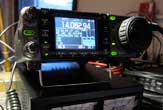Ham Radio Gets Upgraded with Modern Technology

In a world where iPhones enable Internet searches from any location with a good cell signal, communicating with a radio may seem a bit old fashioned. But a new generation of ham radio operators is keeping the tradition alive by combining decades-old radio techniques with modern technology.
Today, tech-savvy radio users bounce their signals off communications satellites, use computers to regulate and record their transmissions and even transmit data over high-power radio frequencies. Far from being obsolete, ham radio is finding new uses in the digital age, including as a backup to the Internet during natural disasters.
“A lot of people cast ham radio as for the older cohort. But there's a lot of younger people involved, [including] some unexpected groups,” said Dave Clausen (radio call sign W2VV), who heads the N2YCR ham radio club.
The club is an offshoot of the New York City-based hacker collective “NYC Resistor” and will join other radio operators in competition and collaboration this weekend as ham users across North America participate in the annual amateur radio Field Day.
On Field Day, radio operators from the U.S. and Canada collaborate to contact new people and broadcast from public places. NYC Resistor plans to host a party in Brooklyn, NY, with a DJ remixing the Morse code, voice conversations and data-pings they pull off ham radio frequencies.
Amateur radio is almost as old as radio itself. The word “ham” is a slang term meaning “unskilled telegraph operator,” according to the American Radio Relay League. Early amateur radio operators adopted the name for themselves to highlight the unprofessional nature of their involvement in radio. [Read "7 Gadgets That Changed the World."]
Today's ham radio
Get the world’s most fascinating discoveries delivered straight to your inbox.
Unlike ham radios from the analog days of vacuum tubes and crystal oscillators, today’s radios have few electronic parts outside of the antenna. Instead, software, not hardware, tunes the radio and converts the message from signals into voice, print or data.
“We use a keyboard for input, and a screen for input, but a HAM radio is the transmission medium in between,” said Joe Taylor, an emeritus professor of physics at Princeton University in New Jersey (radio call sign K1JT ) and a ham radio user.
The computer can correct errors and filter out interference, greatly expanding the range of a small antenna. Additionally, some computers can scan and record multiple frequencies at once, allowing ham users to save hours of conversation to a hard drive for later review.
To extend the range even farther, some ham radio users utilize private communications satellites to relay their signals, Clausen said. Some intrepid radio operators have even bounced their signals off the moon, allowing people on the other side of the globe to hear them, albeit faintly.
Why do it?
Most ham radio operators will concede that even with modern upgrades, radio remains impractical compared to a modern cell phone or the Internet, but they say it still serves an important educational and emergency role.
For example, Princeton's Taylor says his own research, which involves looking for the radio signals produced by distant bodies called pulsars, utilizes many of the same concepts he learned using a ham radio as a child.
Also, in the aftermath of Hurricane Katrina and the recent earthquake in Haiti, amateur radio operators stepped in to help the Red Cross establish communications until more delicate networks like phone and the Internet started working again, N2YCR's Clausen said.
Despite its usefulness in emergency situations, facilitating casual conversations over long distances remains the main function of ham radios. Every user within the signal distance of a radio becomes part of a giant chat room, with all the members united by their interest in amateur radio.
“It's kind of like chatroulette," said NYC Resistor member Diana Eng (call sign KC2UHB). "Except you don't see the other person, and the other person isn't creepy."


